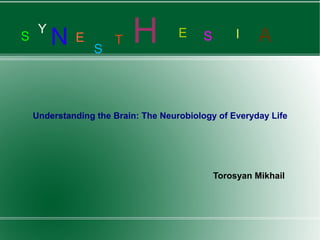Synesthesia
•Télécharger en tant que ODP, PDF•
2 j'aime•1,070 vues
Neurobiology for you.
Signaler
Partager
Signaler
Partager

Recommandé
Contenu connexe
Tendances
Tendances (20)
Attention & Perception - Cognitive Psychology.pptx

Attention & Perception - Cognitive Psychology.pptx
Auditory perception- How sounds are received and interpreted by human beings

Auditory perception- How sounds are received and interpreted by human beings
classical methods of psychophysics (Three methods)

classical methods of psychophysics (Three methods)
Similaire à Synesthesia
Similaire à Synesthesia (20)
Mental imagery in cognitive psychology- maryam amir 

Mental imagery in cognitive psychology- maryam amir
Neuroaesthetics: science embraces art (UX Bristol)

Neuroaesthetics: science embraces art (UX Bristol)
Independent Study: The Psychology of Color in an Interior Space

Independent Study: The Psychology of Color in an Interior Space
Dernier
Dernier (20)
High Profile 🔝 8250077686 📞 Call Girls Service in GTB Nagar🍑

High Profile 🔝 8250077686 📞 Call Girls Service in GTB Nagar🍑
TEST BANK For Radiologic Science for Technologists, 12th Edition by Stewart C...

TEST BANK For Radiologic Science for Technologists, 12th Edition by Stewart C...
Forensic Biology & Its biological significance.pdf

Forensic Biology & Its biological significance.pdf
Formation of low mass protostars and their circumstellar disks

Formation of low mass protostars and their circumstellar disks
Asymmetry in the atmosphere of the ultra-hot Jupiter WASP-76 b

Asymmetry in the atmosphere of the ultra-hot Jupiter WASP-76 b
Biogenic Sulfur Gases as Biosignatures on Temperate Sub-Neptune Waterworlds

Biogenic Sulfur Gases as Biosignatures on Temperate Sub-Neptune Waterworlds
Connaught Place, Delhi Call girls :8448380779 Model Escorts | 100% verified

Connaught Place, Delhi Call girls :8448380779 Model Escorts | 100% verified
FAIRSpectra - Enabling the FAIRification of Spectroscopy and Spectrometry

FAIRSpectra - Enabling the FAIRification of Spectroscopy and Spectrometry
❤Jammu Kashmir Call Girls 8617697112 Personal Whatsapp Number 💦✅.

❤Jammu Kashmir Call Girls 8617697112 Personal Whatsapp Number 💦✅.
High Class Escorts in Hyderabad ₹7.5k Pick Up & Drop With Cash Payment 969456...

High Class Escorts in Hyderabad ₹7.5k Pick Up & Drop With Cash Payment 969456...
Pulmonary drug delivery system M.pharm -2nd sem P'ceutics

Pulmonary drug delivery system M.pharm -2nd sem P'ceutics
Synesthesia
- 1. S Y N E S T H E S I A Understanding the Brain: The Neurobiology of Everyday Life Torosyan Mikhail
- 2. Letters or numbers are colored! Sounds are colored! H o W ? W H Y ? Synesthesia (also spelled synæsthesia or synaesthesia, from the ancient Greek σύν [syn], "together", and α σθησιςἴ [aisthēsis], "sensation") is a neurological phenomenon in which stimulation of one sensory or cognitive pathway leads to automatic, involuntary experiences in a second sensory or cognitive pathway. People who report such experiences are known as synesthetes.
- 3. Alexander Nikolayevich Scriabin Russian composer and pianist. Scriabin was influenced by synesthesia, and associated colors with the various harmonic tones of his atonal scale. For him, circle of fifths was colored
- 4. There are several types of synesthesia. 1. Grapheme-color synesthesia 2. Chromesthesia 3. Spatial sequence synesthesia 4. Number form 5. Auditory-tactile synesthesia 6. Misophonia 7.Mirror-touch synesthesia 8. Lexical-gustatory synesthesia
- 5. Synesthesia is a neurological condition in which two or more bodily senses are coupled. For example, in a form of synesthesia known as Grapheme → color synesthesia, letters or numbers may be perceived as inherently colored. In another, called number → form synesthesia, numbers are automatically and consistently associated with locations in space. In other forms of synesthesia, music and other sounds may be perceived as colored or having particular shapes. Neural basis of synesthesia
- 6. Two major theories have been proposed concerning the neural basis of synesthesia. Both theories start from the observation that there are dedicated regions of the brain that are specialized for certain functions. For example, the part of the human brain involved in processing visual input, called the visual cortex can be further subdivided into regions that are preferentially involved in color- processing (the fourth visual area, V4) or with motion processing, called V5 or MT. Based on this notion of specialized regions, some researchers have suggested that increased cross-talk between different regions specialized for different functions may account for different types of synesthesia. Neural basis of synesthesia
- 7. Maybe the the same mechanism (cross-talk between different regions specialized for different functions )generates our creative and intellectual activity? Why do we fly in our dreams? Why in a dream we see strange creatures? Maybe all the same mechanism? Сross-talk between different regions specialized for different functions . It is wonderful to discover the complicated world of Neurobiology. Thank you. I thoroughly enjoyed the class.
- 8. REFERENCES Hubbard, E. M.; Arman, A. C.; Ramachandran, V. S.; Boynton, G. M. (2005a), "Individual differences among grapheme-color synesthetes: Brain-behavior correlations", Neuron 45 (6): 975–985. Ramachandran, V. S.; Hubbard, E. M. (2001), "Synaesthesia: A window into perception, thought and language", Journal of Consciousness Studies 8 (12): 3–34 Grossenbacher, P. G., Lovelace, C. T. (2001). Mechanism of synesthesia: Cognitive and physiological constraints. Trends in Cognitive Sciences, (5)1, 36–41. The Tell-Tale Brain: A Neuroscientist's Quest for What Makes Us Human, 2010